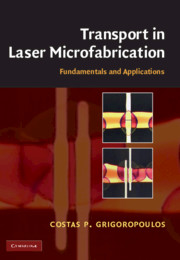Book contents
- Frontmatter
- Contents
- Preface
- 1 Fundamentals of laser energy absorption
- 2 Lasers and optics
- 3 Thermal processes in laser–materials interactions
- 4 Desorption at low laser energy densities
- 5 Dynamics of laser ablation
- 6 Ultrafast-laser interactions with materials
- 7 Laser processing of thin semiconductor films
- 8 Laser-induced surface modification
- 9 Laser processing of organic materials
- 10 Pulsed-laser interaction with liquids
- 11 Laser cleaning of particulate contaminants
- 12 Laser interactions with nanoparticles
- 13 Laser-assisted microprocessing
- 14 Nano-structuring using pulsed laser radiation
- Index
- References
14 - Nano-structuring using pulsed laser radiation
Published online by Cambridge University Press: 04 December 2009
- Frontmatter
- Contents
- Preface
- 1 Fundamentals of laser energy absorption
- 2 Lasers and optics
- 3 Thermal processes in laser–materials interactions
- 4 Desorption at low laser energy densities
- 5 Dynamics of laser ablation
- 6 Ultrafast-laser interactions with materials
- 7 Laser processing of thin semiconductor films
- 8 Laser-induced surface modification
- 9 Laser processing of organic materials
- 10 Pulsed-laser interaction with liquids
- 11 Laser cleaning of particulate contaminants
- 12 Laser interactions with nanoparticles
- 13 Laser-assisted microprocessing
- 14 Nano-structuring using pulsed laser radiation
- Index
- References
Summary
Introduction
Fundamental understanding of microscale phenomena has been greatly facilitated in recent years, largely due to the development of high-resolution mechanical, electrical, optical, and thermal sensors. Consequently, new directions have been created for the development of new materials that can be engineered to exhibit unusual properties at sub-micrometer scales. Surface engineering is a critical sub-field of nanotechnology because of the paramount importance of surface-interaction phenomena at the micro/nano-machine level. Nanofabrication of complex three-dimensional patterns cannot be accomplished with conventional thermo-chemo-mechanical processes. While laser-assisted processes have been effective in component microfabrication with basic dimensions in the few-micrometer range, there is an increasing need to advance the science and technology of laser processing to the nanoscale. Breakthroughs in various nanotechnologies, such as information storage, optoelectronics, and bio-fluidics, can be achieved only through basic research on nanoscale modification and characterization of surfaces designed to exhibit special topographical and compositional features at high densities.
Since their invention in the 1980s, scanning-microscopy techniques such as scanning tunneling microscopy (STM), atomic-force microscopy (AFM), scanning near-field optical microscopy, and further variants thereof, have not only become indispensable tools for ultrahigh-resolution imaging of surfaces and measurement of surface properties but also offered hitherto unexplored possibilities to locally modify materials at levels comparable to those of large atoms, single molecules, and atomic clusters. These nanometric investigation tools have been used extensively in numerous high-resolution nanostructuring studies, to manipulate single atoms, and also as effective all-inclusive nanofabrication tools.
- Type
- Chapter
- Information
- Transport in Laser MicrofabricationFundamentals and Applications, pp. 376 - 398Publisher: Cambridge University PressPrint publication year: 2009



